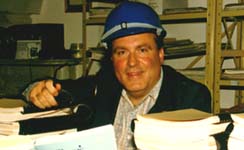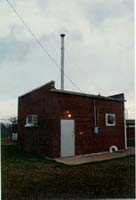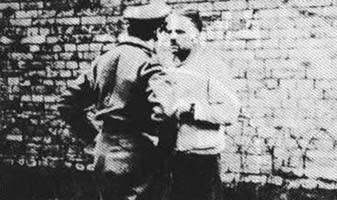 Ernst
Zündel
Ernst
Zündel  Ernst
Zündel
Ernst
Zündel It does not need to be explained. It did not happen that way. Due to
the poorly designed ventilation systems installed in two of the gas chambers
and the absence of any ventilation system in the others (see Q. 30), this
scenario is simply impossible. Be sure to double-check the testimony
of Kenneth Wilson at the Second (1988) Zündel Trial, to be perused
at the aforementioned and oft-repeated ("Did
Six Million Really Die?" summary, page 353. (Click on the
Kenneth Wilson chapter!)
However, I will concede that this question needs further investigation,
if for no other reason than to dispell the last whiff of doubt. I personally
stand by my belief that the preponderance of the evidence suggests that
the absence of physical evidence such as missing exhauster units
etc. is significant.

Researchers who have climbed all over the Auschwitz ruins have not discovered
any studs, bolts or any mountings that can be seen for these alleged "exhauster
units" in any of these camps. Aereal photographs taken by the US and
South African Air Force during the war don't reveal the tell-tale tall
exhaust stacks, such as can be found in US gassing installations such as
the Parchmount Mississippi Death House, installed to avoid gassing non-death
row inmates, guards or camp administrators, both civilian and military.
(The Leuchter Report
# 3, available on the Zundelsite, will answer additional questions
regarding instructions for gassing procedures.)
Additionally, even the allegation that in the alleged gas chambers of Krema
II and III ". . . wire-mesh devices to remove the Zyklon-B from the
chambers, improving the efficiency of the ventilation process", had
been installed, is frankly invented, since there are still today no holes
in the roof through which a wire mesh device could have been placed and
removed - not to mention the impossibility of filling Zyklon-B through
a massive concrete ceiling without holes in it! (Quotation: part of Nizkor's
answer to this question; cp. R. Kammerer, op. cit.)
Take an eraser and wipe the image of "eating, drinking, smoking corpse
handlers" out of your memory! Kommandant
Hoess, who was beaten nearly to a pulp and whose family was threatened
with being sent to a Siberian concentration camp, would have said anything.

However, I will concede that other researchers feel that the question
is extraneous to the argument of whether or not gassings took place - simply
because stronger evidence than the absence of studs, bolts and mountings
is available.
 For instance,
Germar Rudolf of the
brilliant "Rudolf Report" wrote:
For instance,
Germar Rudolf of the
brilliant "Rudolf Report" wrote:
"There is simply no possibility to check if in the former buildings there have been "studs, bolts or mountings" . . . which would have to include a complete excavation of the crematoria ruins and a massive research for such devices or their remainders in them. The drawings of the buildings give us no clue, but this may be simply due to the fact that such small and very special devices would probably not have been drawn into them.
A quick look into the ruins of Krema II and III, such as Felderer, Faurisson, Mattogno, Leuchter and I did, is absolutely not enough to settle this question. And the reconstruction of Krema I and the nearly completely disappeared Kremas IV and V are not "researchable".
I think that Robert Faurisson is exaggerating the danger which would have arisen from the alleged mass gassings. Fact is that in a couple of delousing facilities in Birkenau a massive daily use of Zyklon B didn't affect the security of either the prisoners or the guards - WITHOUT any tall airing/exhauster stacks. . . "
As Nizkor can see, Revisionists are living up to their name, even if
they revise each other in light of the need to investigate further!